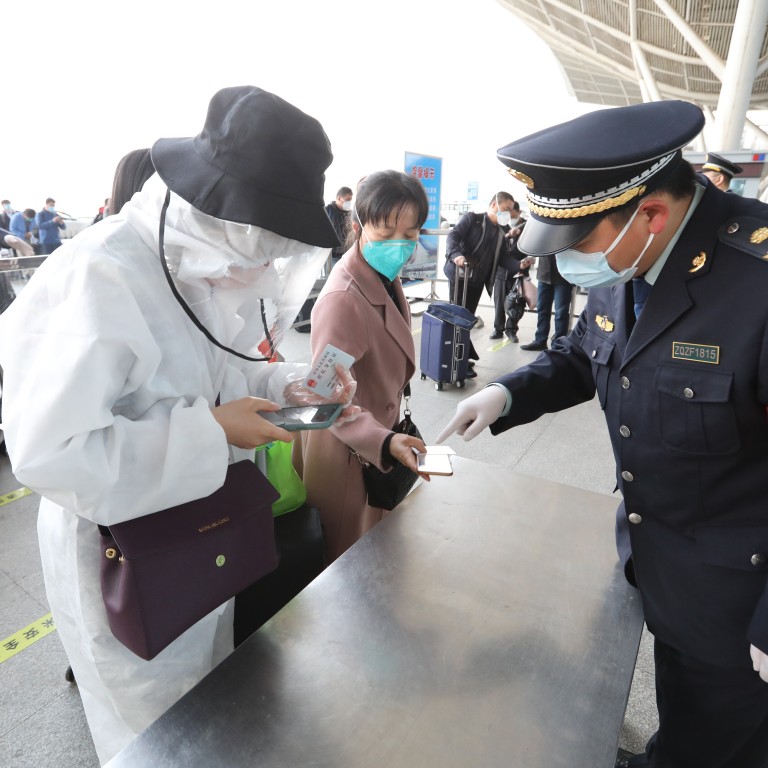
Wuhan on the move again as coronavirus lockdown limits ease
- Travellers flood the city’s train station and traffic returns to roads and highways after more than two months of confinement
- Unease persists, with some wearing full protective clothing and wary of leaving their homes
Highways, bridges, ferries and tunnels are also open again and all roadblocks have been removed.
On Wednesday morning, traffic jams returned to the intersection near Wuhan Railway Station in congestion not seen since late January.
Passengers covered in hats, gloves, goggles and even full protective clothing headed for the station’s entrance, forming long queues at the transport hub by 8am.

Witnesses said there appeared to be more people at the station than the exodus just before the lockdown on January 23 that brought transport in and out of the city to a standstill.
At the station, loudspeakers blared announcements reminding passengers to wear masks and keep a safe distance from each other – a sharp contrast to the absence of warnings and temperature checks before the closure.
Passengers had to show their QR code and ID card and have their temperature checked before being allowed to pass through boarding gates, as dozens of volunteers in yellow and red jackets stood by to help maintain order.
A station employee, who declined to be named, said the queues reminded her of the travel surge before national holidays.
“We only see these kinds of scenes on public holidays, like Labour Day,” she said.
Zhang Zhenguo, 28, who works for a construction company, said he was excited to finally be able to go to Xuzhou, in the eastern province of Jiangsu, for work after being trapped in Wuhan.
“I feel relieved that our country is still the same and people are safe and sound,” Zhang said.
Wearing a protective suit and goggles, Xie Linfu, a 30-year-old teacher at a university in Shenzhen bordering Hong Kong, was also relieved to be on the move again.
State-owned operator China Railway estimated that 55,000 passengers would leave the city on Wednesday, of which 40 per cent were expected to travel to the Pearl River Delta in the souther province of Guangdong, news website Thepaper.cn reported on Tuesday.
More than 275 services would leave Wuhan for other major transport hubs such as Shanghai, Shenzhen, Chengdu and Fuzhou.
People aiming to return to Beijing from Wuhan face some of the biggest challenges – they must have a nucleic acid test and test negative for the virus before they can enter the capital,Beijing Daily reported on Wednesday.
Authorities have set up a designated channel for these travellers at the station. More than a dozen staff in masks and protective clothing were on standby nearby in case passengers with health problems or other emergencies needed to be sent back to their various districts in the city.
Li Tingrui, a 19-year-old university student in Wuhan and a volunteer at the station, said returnees to Beijing needed to apply through a smartphone application to get approval to return to capital. After that they could buy tickets, get tested and show their health code before leaving Wuhan.

About 2km (1.2 miles) away at toll booths on the Gongjialing highway, cars and trucks streamed through, with motorists and passengers not required to show their health code or get their temperature checked.
Near the booths, two farmers from Henan province, also in central China, were piling up bags of chillies on their truck.
One of the farmers said she returned to Wuhan on Tuesday and planned to sell the produce in surrounding areas to try to generate much-needed income. She said she had not had any money coming in for more than three months.
Though the lockdown has been lifted, some residents in Wuhan still feel unsafe and are reluctant to leave home.
Zhang Jinyu, a 58-year-old retired teacher in a neighbourhood close to the Huanan Seafood Wholesale Market, the wet market where some of the first cases of Covid-19 were reported, said she was still worried about asymptomatic carriers and was not going out unless it was necessary.
Zhang said the controls on movements at residential compounds were still strict, and only one person could go out once a day in her estate.
“We are so bored at home, but we totally understand and will cooperate,” she said. “I just wish the outbreak can pass soon so that we can move freely again.”
Sign up now and get a 10% discount (original price US$400) off the China AI Report 2020 by SCMP Research. Learn about the AI ambitions of Alibaba, Baidu & JD.com through our in-depth case studies, and explore new applications of AI across industries. The report also includes exclusive access to webinars to interact with C-level executives from leading China AI companies (via live Q&A sessions). Offer valid until 31 May 2020.

